The Intel SSD 330 Review (60GB, 120GB, 180GB)
by Anand Lal Shimpi on August 1, 2012 12:01 AM ESTAnandTech Storage Bench 2011
Two years ago we introduced our AnandTech Storage Bench, a suite of benchmarks that took traces of real OS/application usage and played them back in a repeatable manner. I assembled the traces myself out of frustration with the majority of what we have today in terms of SSD benchmarks.
Although the AnandTech Storage Bench tests did a good job of characterizing SSD performance, they weren't stressful enough. All of the tests performed less than 10GB of reads/writes and typically involved only 4GB of writes specifically. That's not even enough exceed the spare area on most SSDs. Most canned SSD benchmarks don't even come close to writing a single gigabyte of data, but that doesn't mean that simply writing 4GB is acceptable.
Originally I kept the benchmarks short enough that they wouldn't be a burden to run (~30 minutes) but long enough that they were representative of what a power user might do with their system.
Not too long ago I tweeted that I had created what I referred to as the Mother of All SSD Benchmarks (MOASB). Rather than only writing 4GB of data to the drive, this benchmark writes 106.32GB. It's the load you'd put on a drive after nearly two weeks of constant usage. And it takes a *long* time to run.
1) The MOASB, officially called AnandTech Storage Bench 2011 - Heavy Workload, mainly focuses on the times when your I/O activity is the highest. There is a lot of downloading and application installing that happens during the course of this test. My thinking was that it's during application installs, file copies, downloading and multitasking with all of this that you can really notice performance differences between drives.
2) I tried to cover as many bases as possible with the software I incorporated into this test. There's a lot of photo editing in Photoshop, HTML editing in Dreamweaver, web browsing, game playing/level loading (Starcraft II & WoW are both a part of the test) as well as general use stuff (application installing, virus scanning). I included a large amount of email downloading, document creation and editing as well. To top it all off I even use Visual Studio 2008 to build Chromium during the test.
The test has 2,168,893 read operations and 1,783,447 write operations. The IO breakdown is as follows:
| AnandTech Storage Bench 2011 - Heavy Workload IO Breakdown | ||||
| IO Size | % of Total | |||
| 4KB | 28% | |||
| 16KB | 10% | |||
| 32KB | 10% | |||
| 64KB | 4% | |||
Only 42% of all operations are sequential, the rest range from pseudo to fully random (with most falling in the pseudo-random category). Average queue depth is 4.625 IOs, with 59% of operations taking place in an IO queue of 1.
Many of you have asked for a better way to really characterize performance. Simply looking at IOPS doesn't really say much. As a result I'm going to be presenting Storage Bench 2011 data in a slightly different way. We'll have performance represented as Average MB/s, with higher numbers being better. At the same time I'll be reporting how long the SSD was busy while running this test. These disk busy graphs will show you exactly how much time was shaved off by using a faster drive vs. a slower one during the course of this test. Finally, I will also break out performance into reads, writes and combined. The reason I do this is to help balance out the fact that this test is unusually write intensive, which can often hide the benefits of a drive with good read performance.
There's also a new light workload for 2011. This is a far more reasonable, typical every day use case benchmark. Lots of web browsing, photo editing (but with a greater focus on photo consumption), video playback as well as some application installs and gaming. This test isn't nearly as write intensive as the MOASB but it's still multiple times more write intensive than what we were running in 2010.
As always I don't believe that these two benchmarks alone are enough to characterize the performance of a drive, but hopefully along with the rest of our tests they will help provide a better idea.
The testbed for Storage Bench 2011 has changed as well. We're now using a Sandy Bridge platform with full 6Gbps support for these tests.
AnandTech Storage Bench 2011 - Heavy Workload
We'll start out by looking at average data rate throughout our new heavy workload test:
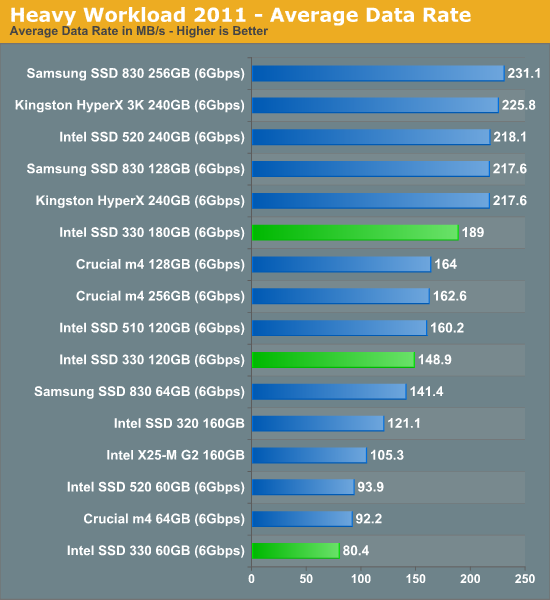
Our heavy storage bench suite shows average performance for Intel's SSD 330. There's a bit of a gap between it and the SSD 520 as well.
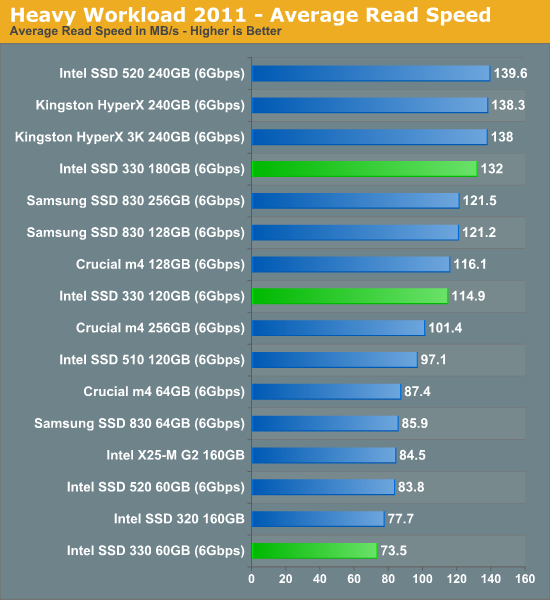
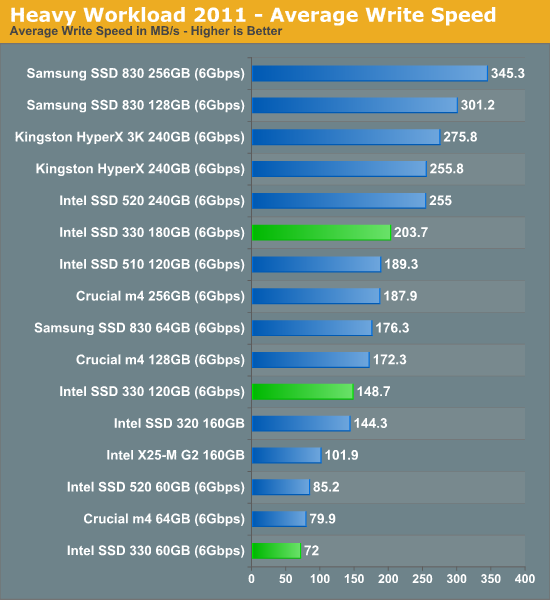
The next three charts just represent the same data, but in a different manner. Instead of looking at average data rate, we're looking at how long the disk was busy for during this entire test. Note that disk busy time excludes any and all idles, this is just how long the SSD was busy doing something:
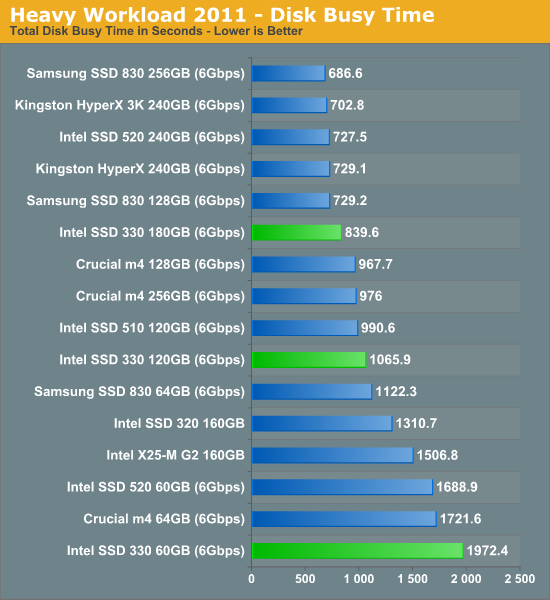
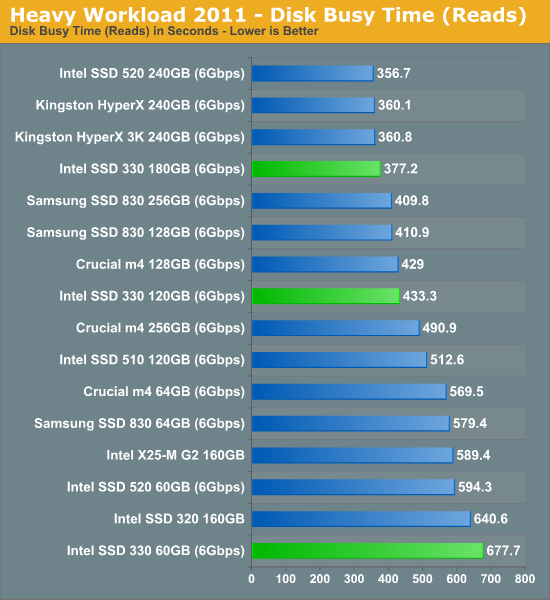
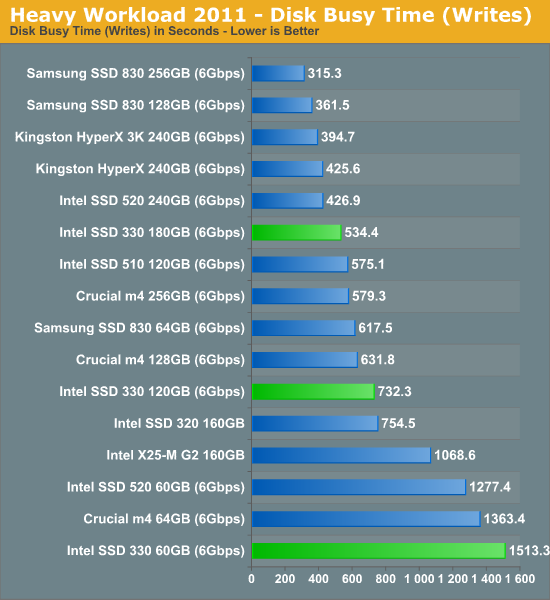










64 Comments
View All Comments
Ryan Smith - Wednesday, August 1, 2012 - link
"I just wish Anand more honest by telling people the truth about SSD, specially SF based controller, because after trying more than 5 SF based SSD, I can say they're sucks! buy it only if you're planning to reformat your drive every now and then"So far every problem we've encountered with SF-2xxx has been documented, e.g. http://www.anandtech.com/show/5508/intel-ssd-520-r...
Beyond that we haven't encountered any additional SF-2xxx issues in our extended deployment testing. For example the 520 (330's sibling) is currently in one of my systems, having replaced a 120GB Vertex 2 that just recently passed 2 years of service.
amikey - Wednesday, August 1, 2012 - link
I have a 180GB SSD 330 in my 2009 Macbook Pro 13". It's totally fine, and running better than ever.Haven't enabled trim or updated the firmware since I got it (no pc to use) either.
I don't use disk encryption though, if you were to do that go with something else.
angelsmaster - Tuesday, September 4, 2012 - link
hi, you didn't update it or whatever? is it still up and running? and i think, its not trim supported when i checked it in the S-ATA system report, btw, i am using a macbook pro 15" 2011... thanks..quanstro - Wednesday, August 1, 2012 - link
how did you get this kind of experience with a just-released drive in a year-old computer?Jumpman23 - Wednesday, August 1, 2012 - link
In terms of cost and reliability the 330 seems like a good deal. What about in terms of performance and reliability? I've been hearing not so good things about the SF drives in general. The M4's and Samsung's 830 seems to get good reviews. So is there any particular drive that stands out as the best of the best?Per Hansson - Wednesday, August 1, 2012 - link
OCZ has a really poor track record when you look at RMA's:http://www.behardware.com/articles/862-7/component...
Weather this is due to the BSOD issue or other issue with their Sandforce drives I don't know.
But if you look at future data even OCZ's Petrol & Octane series has really bad RMA rates:
http://www.behardware.com/articles/862-8/component...
This makes me kind of weary of any Sandforce drive, we can see that since Intel has released Sandforce drives their failure rate has gone from 0.6% > 1.73% in the first link above.
This could be because of the "8MB bug" only but I am not convinced.
I would go for the Crucial M4 drive at this point, it has a great track record and only one known very specific problem (BSOD after 50k hours of ontime, caused by a bug in the SMART values & fixed by a firmware update)
Kristian Vättö - Wednesday, August 1, 2012 - link
The problem with those statistics is that they are extremely limited. Only four manufacturers are listed, and only OCZ's numbers are reported for individual models. The only info on sample size is that there must have been over 500 sales (brand) or 100 sales (model).I'm not defending OCZ or any other brand, just pointing out that a more thorough study would be needed to really know what SSDs are reliable. I do agree that Crucial's m4 is a great buy at the moment, and Samsung 830 and Plextor's SSDs are too.
lyeoh - Wednesday, August 1, 2012 - link
Only OCZ's numbers are reported for individual models becausequoting the article: "only OCZ has models with rates of above 5%".
You may need a more thorough study, but it's good enough for me to avoid OCZ.
Per Hansson - Wednesday, August 1, 2012 - link
Yea, it's a limited sample size but it's all we have to go on.We can also look at Newegg reviews, sure it has it's drawbacks aswell but when you see stuff like this it paints a quite clear picture I think:
128GB OCZ Petrol: http://www.newegg.com/Product/Product.aspx?Item=N8...
128GB OCZ Octane: http://www.newegg.com/Product/Product.aspx?Item=N8...
120GB OCZ RevoDrive 3: http://www.newegg.com/Product/Product.aspx?Item=20...
240GB OCZ Vertex 3: http://www.newegg.com/Product/Product.aspx?Item=N8...
128GB OCZ Vertex 4: http://www.newegg.com/Product/Product.aspx?Item=N8...
128GB Crucial M4: http://www.newegg.com/Product/Product.aspx?Item=N8...
antef - Wednesday, August 1, 2012 - link
I recommend the m4, it's been an amazing drive for me and the reviews on Newegg and Amazon are out of this world, the kind of thing you don't see very often. Don't fret over exact performance and worry that a newer drive might net you something slightly higher, all of these are crazy fast, my Windows machine with the m4 stays on the loading screen for all of 3 seconds, not even enough time to see the four colored orbs form together into the Windows logo.